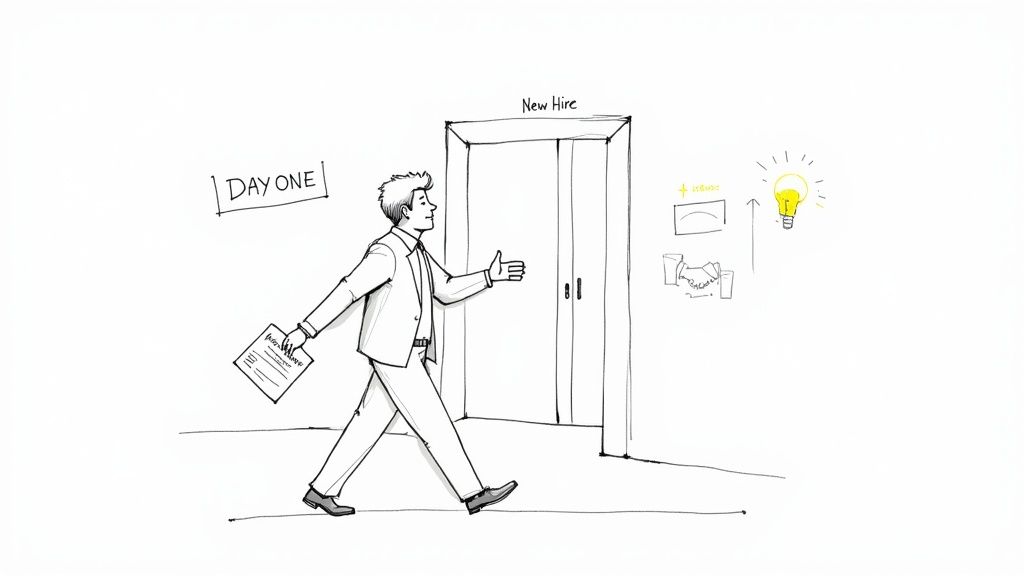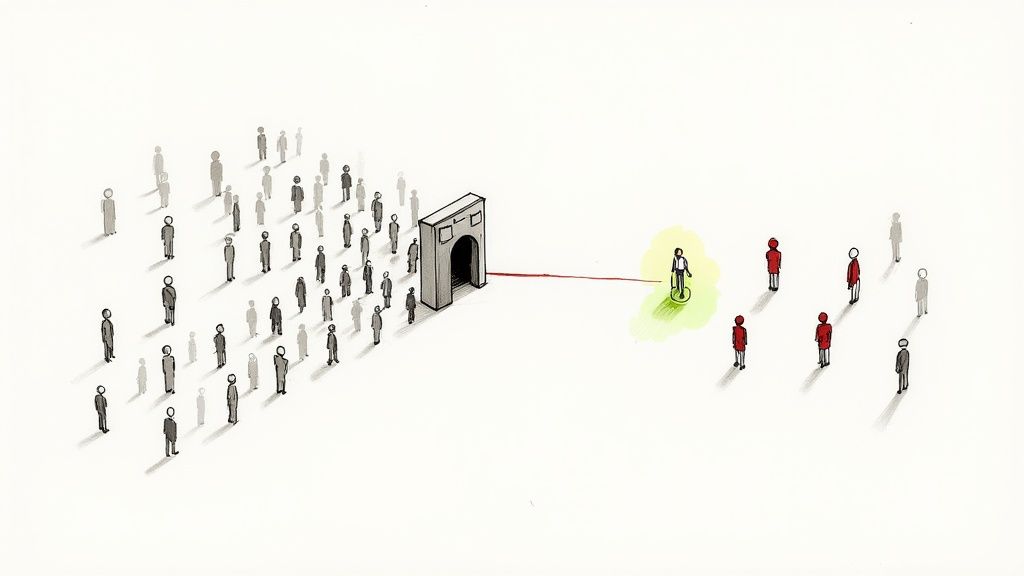Interview feedback. It’s that thing everyone knows they should do, but it usually ends up as a rushed, generic email sent three weeks too late. Let’s be real: it’s often a low-priority, administrative chore that silently sabotages your hiring.
When done poorly—or not at all—it sends your best candidates sprinting to your competitors. It’s the silent killer of a great talent pipeline. And you’re probably doing it wrong.
Why Your Interview Feedback Is Quietly Sabotaging Your Hiring
Most interview feedback is the corporate equivalent of “it’s not you, it’s me.” It’s generic, late, or just plain nonexistent. Every candidate on the receiving end knows it means absolutely nothing.
This isn’t a small problem. It’s a systemic failure rooted in a few painful realities: busy managers who forget details three minutes after an interview, vague internal notes that offer zero real insight, and a paralyzing fear of litigation that forces everything through a bland, HR-approved filter.
The result? Hope you enjoy spending your afternoons fact-checking resumes and running technical interviews—because that’s now your full-time job if your process keeps burning bridges with great people.
The Real Cost of Bad Feedback (aka The $500 Hello)
Getting interview feedback wrong isn’t just impolite; it’s tangible, bottom-line damage. Every time you ghost a candidate or send a template rejection, you’re not just closing one door—you're poisoning the entire well for future hires.
This isn't just a gut feeling; the data is painfully clear. A staggering 94% of candidates want to receive interview feedback. When they actually get it, they are four times more likely to consider applying to your company again. That positive experience also makes them 79% more likely to refer others from their network. You can explore more recruiting statistics that prove this isn't just fluffy HR talk.
So, what happens when you drop the ball?
- You torpedo your employer brand: Word gets around. A bad candidate experience travels fast on platforms like Glassdoor and LinkedIn, branding you as disorganized or disrespectful.
- You lose future all-stars: The great developer you rejected today could be the perfect senior architect in two years. But they won’t be back. Not a chance.
- You basically work for your competitors: A candidate who gets a thoughtful, respectful rejection from your competitor and radio silence from you knows exactly where they’d rather work next time.
It's easy to think you're communicating clearly, but the gap between what you do and what candidates experience can be a canyon. Your well-intentioned process (or lack thereof) often comes across as dismissive and unprofessional, causing real harm to your brand without you even realizing it.
The Feedback Gap: What You Say vs. What They Hear
| Your Action (or Inaction) | The Candidate's Reality | The Damage Done |
|---|---|---|
| Sending a generic, template rejection email. | "My application wasn't even seriously considered." | Alienates the candidate and makes them unlikely to reapply or refer others. |
| Ghosting them completely after an interview. | "They're unprofessional and don't respect my time." | Annihilates your employer brand and fuels negative online reviews. |
| Providing vague feedback like "we went with a better fit." | "They have no idea what they're looking for and can't give a straight answer." | Creates frustration and makes your company seem disorganized or indecisive. |
| Taking weeks to get back to them with a decision. | "They're not interested, or their process is a mess. I'm moving on." | You lose out on top talent who receive and accept offers from faster-moving competitors. |
Closing this gap isn't about lengthy critiques for every applicant. It's about being respectful, timely, and human. A little thoughtful communication goes a very long way in turning a rejection into a positive brand touchpoint.
Giving meaningful feedback is one of the highest-leverage, lowest-cost ways to build a world-class hiring reputation. It transforms a transaction into a relationship, even when the outcome is a 'no.'
How to Capture Feedback That Isn’t a Total Waste of Time
Let’s be honest. If your method for collecting interview feedback is a hurried Slack message asking, “So, what did you think?”—you don’t have a process. You have a guessing game. Vague, subjective notes scribbled on a resume are the fastest way to make a bad hire or, even worse, pass on a great one.
To get feedback that’s actually useful, you need to ditch the “gut feelings” and build a simple, structured system. It doesn’t have to be complicated. We’re not trying to build a rocket ship here; we’re just trying to figure out if someone can actually do the job.
The goal is to turn rambling opinions into clean, actionable data. This isn’t just for your benefit—it’s the raw material you’ll need to give candidates the meaningful closure they deserve.
This quick flow shows how easily bad feedback can spiral, hurting your brand and losing you great candidates.
As you can see, what starts as a small internal misstep—poorly captured feedback—quickly snowballs into significant external consequences for your talent pipeline.
Build a Scorecard, Not an Essay Contest
Your first move? Create a simple scorecard. This is your best defense against bias and lazy feedback. Just focus on 3-5 core competencies for the role and have every single interviewer score the candidate on those points. Nothing more, nothing less.
This one document forces everyone to assess candidates against the same objective criteria. It’s how you turn subjective impressions into comparable data points. You can learn more about creating a powerful interview evaluation form to standardize your process. Don't overthink it. Just build it.
The Three Bullets Rule
Even your busiest hiring manager can find 90 seconds to give you what you need. Just ask for three bullet points immediately after the interview wraps up:
- One major strength directly related to a core competency.
- One potential area of concern or a skill gap they identified.
- A clear hire/no-hire recommendation.
That’s it. This simple trick forces clarity and gives you concrete talking points for your debrief. No more trying to decode a wall of text written three days after the fact when memories have gone fuzzy. For more practical advice on making interview feedback more impactful, check out Parakeet AI's blog.
The single most important rule of interview feedback is to capture it immediately. Every hour that passes degrades the quality of the insights by half. Don’t let perfect be the enemy of good—get the notes down now.
Technology can be a huge ally here. In fact, 99% of U.S. hiring managers now use AI in their process, with 98% of them reporting real efficiency gains. Tools that prompt for immediate feedback or help transcribe key moments can reduce time-to-hire by up to 26%, making sure you capture sharp, relevant insights while they’re still fresh. You can read the full research on AI in hiring for more details.
The Art of Delivering Tough News with Class
Nobody enjoys sending rejection letters. It’s the corporate equivalent of breaking up with someone you’re just not that into. But delivering bad news with respect isn’t just about being nice; it’s a brand-building superpower.
This is your tactical guide to rejecting a candidate in a way that makes them admire your company, not resent it. It’s about closing the door gracefully instead of slamming it in their face. A little class goes a long way.

Ditch the Compliment Sandwich
The old-school "compliment sandwich"—one piece of praise, one piece of criticism, and one more piece of praise—is stale, and everyone can taste it. Candidates see right through this fluffy, condescending tactic. It feels disingenuous because it is.
Your goal isn’t to soften the blow with fake pleasantries. It's to provide one or two specific, objective data points they can actually use. Real, honest feedback on their interview performance is a gift, even when it’s tough to hear.
Stop trying to make people feel better about being rejected. Start giving them information that helps them get the next job. That’s how you build a reputation that attracts A-players.
Be Specific Without Being Brutal
Vagueness is your enemy. "Lacked experience" is lazy feedback. It's a dead end that tells the candidate nothing. Instead, you need to connect your feedback directly to the role's requirements.
Get concrete with your language. Try these shifts:
-
Instead of: "You lacked the necessary technical skills."
-
Try: "We prioritized candidates who had direct experience with Python and deploying machine learning models at scale."
-
Instead of: "We went with someone who was a better culture fit."
-
Try: "For this role, we needed someone who has led a fully remote team across multiple time zones, which was a key experience for us."
See the difference? The first version is a judgment. The second is a statement of business priority. One feels personal and dismissive; the other is professional and clear. This approach also minimizes legal risk by sticking to objective, role-based criteria. For more inspiration, you can check out these candidate feedback examples that strike the right balance.
Choose Your Medium Wisely
How you deliver the message matters almost as much as the message itself. Your choice signals how much you valued the candidate’s time and effort.
- Email is fine for early-stage rejections. If they only submitted an application or had a brief initial screen, a well-written, personalized email is perfectly acceptable. Just make sure it’s not a generic template.
- A phone call is better for late-stage candidates. If someone has invested multiple hours meeting with your team and completing a project, they’ve earned a five-minute phone call. It’s a sign of respect that they won’t forget.
Delivering this kind of feedback on interview results isn't easy, but it’s what separates average companies from brands that top talent actively wants to join. It shows you’re confident, transparent, and respectful—qualities everyone looks for in an employer.
Using Feedback to Supercharge Your Onboarding
Think the feedback process ends once you’ve sent the offer letter? Rookie mistake. Most companies drop the ball here, treating feedback as a tool exclusively for rejected candidates. The real goldmine is the feedback you gathered on the person you just hired.
This isn't about nitpicking weaknesses. It’s about turning the insights from your interview process into a day-one advantage. You’ve just spent hours learning what makes this person tick—why on earth would you lock that information away in an applicant tracking system, never to be seen again?

Create a "Welcome Feedback" Doc
Let's get tactical. Take the most potent, positive highlights from your team’s interview notes and distill them into a one-page "Welcome Feedback" document. This isn’t a performance review; it’s a highlight reel. Share it with the new hire and their direct manager before their first day.
The goal is to validate their strengths and explicitly state why you hired them. This small gesture accomplishes several critical things right out of the gate:
- It makes them feel seen: They know you weren't just ticking boxes. You paid attention.
- It kills buyer's remorse: It confirms they made the right choice by joining a company that values what they bring to the table.
- It sets clear expectations: It tells them exactly which of their skills you’re most excited about them using.
You’re not just onboarding an employee; you’re starting a relationship. Kicking it off by showing them you understand their strengths is the fastest way to build a foundation of trust.
How to Frame Positive Feedback for New Hires
Be specific. Connect their demonstrated skills to real-world team needs. Ditch generic praise and focus on concrete examples from their interview. It shows you were listening and gives them a clear signal about where to direct their energy.
-
Instead of: "We were impressed with your background."
-
Try: "During the technical interview, your approach to solving the database optimization problem was exactly the kind of clear, logical thinking our engineering team needs. We’re excited to see you apply that here."
-
Instead of: "You had great communication skills."
-
Try: "The way you presented your case study showed a real talent for making complex data accessible. We know you’ll be a huge asset in our client-facing discussions with the sales team."
This isn't about stroking egos. It's about strategic alignment. You’re giving your new hire a roadmap to early wins by reminding them of the superpowers you hired them for. It’s a low-effort, high-impact move that sets the tone for everything to come.
Turn Your Feedback into a Smarter Hiring Engine
So, you’re delivering thoughtful feedback to candidates. Great. But if you stop there, you're leaving the biggest prize on the table. Giving feedback to one person is a tactic; analyzing all of it is a strategy.
Let’s zoom out. The real power of collecting structured interview notes isn’t just about closing the loop with one candidate. It’s about turning all those individual data points into a machine that makes your entire hiring process smarter, faster, and way less biased.
This is where you graduate from simply filling roles to building a genuine competitive advantage.
Run a Quarterly Feedback Retrospective
Think of your aggregated interview feedback as an internal business intelligence tool. Once a quarter, sit down with your hiring leads and treat this data like any other critical business metric. Your goal is to hunt for patterns—both good and bad.
What are you looking for? Start here:
- Recurring Skill Gaps: Are you constantly rejecting candidates for lacking a specific skill? Maybe the problem isn't the talent pool. Maybe your job description is attracting the wrong people.
- Misaligned Interviewers: Is one person on your panel consistently an outlier, either loving or hating candidates everyone else agrees on? That’s not high standards; it’s a red flag for a miscalibrated interviewer who needs coaching.
- Useless Questions: Are certain interview questions consistently yielding generic answers? Ditch them. Refine your question bank based on what actually predicts success.
This process isn't about pointing fingers. It's about spotting leaks in the boat before they sink it.
A well-structured review, guided by tools like clear scoring sheets for interviews, can show you where your process is failing long before you make a costly bad hire.
Interview feedback isn't just a record of the past; it's a predictive model for your future hiring success. If you're not analyzing the aggregate data, you're flying blind.
From Data Points to Smarter Decisions
Once you spot these patterns, you can take clear, decisive action.
For example, if you realize your technical assessment is filtering out candidates who have strong practical skills but weaker theoretical knowledge, you can redesign it. If feedback shows bias creeping in around subjective terms like "culture fit," you can train your team to focus on objective, values-aligned behaviors instead.
By turning feedback into a smarter hiring engine, you can even implement an ethical and proactive guide to preventing insider threats, protecting your organization from the inside out by simply making better hiring decisions upfront.
The insights are right there in your notes. This is how you stop making the same hiring mistakes over and over. You analyze, you adjust, and you build a hiring engine that gets more accurate with every single interview cycle.
Frequently Asked Questions About Interview Feedback
Alright, let's tackle some of the questions that always pop up when teams get serious about this stuff. This is the part that sounds simple on paper but often trips people up when the rubber meets the road.
We’ve seen it all. Let's dive in.
How Much Feedback Is Too Much for a Rejected Candidate?
Keep it concise. Keep it actionable. You're not writing a performance review for a stranger. Your goal is to offer one helpful, concrete takeaway that doesn't feel like a personal attack.
Stick to one or two high-level points directly tied to the core requirements of the role. Overloading someone with a laundry list of critiques is just cruel and unhelpful.
A simple, honest, and brief explanation is far more powerful than an essay justifying your decision. Focus on one specific skill or experience they were missing, and then move on.
For example, ditch the vague "we went with a stronger candidate." Instead, try: "We ultimately moved forward with a candidate who had direct experience managing project budgets over $500,000." It’s specific, objective, and gives them a real benchmark without getting personal.
What if Our Legal Team Forbids Specific Feedback?
Ah, the big one. The ghost story that keeps HR departments up at night. It's a legitimate concern, but the fear is often based on outdated advice.
The key is to keep all feedback objective, consistent, and role-related. This is your mantra. Steer clear of subjective comments about personality or that dreaded, undefinable "culture fit." Anything that sounds like a personal judgment is a huge red flag.
So, instead of saying, "you weren't confident enough," frame it around a tangible skill: "We prioritized candidates with more direct experience presenting to executive leadership." One is a subjective opinion; the other is a verifiable business need.
The best approach? Work with your legal team once to create a structured, scorecard-based feedback framework. Show them how you're evaluating candidates against predefined competencies. Taking this proactive step almost always gets them comfortable with a modern, low-risk approach.
How Do We Standardize Feedback Across Our Interviewers?
If you don't standardize, you're just collecting a jumble of disconnected opinions. Standardization is everything if you want fair evaluations and data you can actually use.
Here's the playbook that works time and time again:
- Define 3-5 Core Competencies: Before the first interview, get the hiring team to agree on the absolute must-have skills for the role. Think 'Problem Solving,' 'Technical Proficiency,' or 'Client Communication.'
- Use a Simple Scale: Have every interviewer rate the candidate on those competencies using a simple 1-5 scale. That's it.
- Require Written Evidence: This is crucial. Each interviewer must provide a short paragraph of evidence to support their ratings. This forces them to justify their scores and moves everyone away from lazy, "gut feeling" assessments.
This simple structure makes sure everyone is playing the same game and evaluating candidates against the same objective yardstick.
Ready to stop guessing and start building a world-class hiring process? Async Interview gives you the tools to capture structured feedback, collaborate with your team, and make smarter hiring decisions—up to 10x faster. (Toot, toot!)




